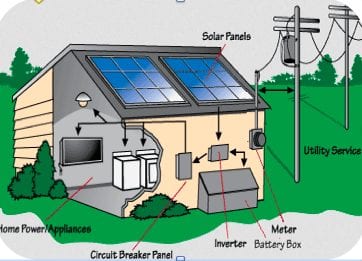The plunging cost of solar PV means that it may now be half the cost of grid-based electricity, according to some industry estimates. But the economics of buying solar PV systems is still not clear for those who cannot consume most of the energy produced on their rooftops, because owners of rooftop solar systems are now getting paid little or nothing for the electricity they export.
So perhaps the time is approaching when the question should be asked: is it worth considering energy storage? Is it cost effective? Should householders go it alone, or in a community group? And what are the implications for other network users? Already, network operators and generators are bleeding because every solar panel that is added reduces demand and eats away at their centralised generation model. Batteries would only accelerate that change.
These were a series of questions that were posed by Gordon Weiss, an energy expert from the consultancy and advisory firm Energetics at the recent 2nd Summer Study into Energy Efficiency and Decentralised Energy in Sydney.
The first question is a bit of a no-brainer. As we wrote last Tuesday, the cost of solar PV has fallen to the extent that it has achieved “socket parity” in many places in Australia. Weiss thinks it’s even better than that. His estimates of the levellised cost of solar PV is between 12c/kWh and 14c/kWh, meaning that it is half the cost of electricity bought from the grid.
See the graph below for an illustration of these costs. For the energy and technology wonks, Weiss bases his assumptions on two different system sizes, assuming 14 per cent capacity factor, a 7 per cent discount rate, and a 30-year economic life.
 This leads to the next problems. Generating electricity at this price is a no brainer when most of it can be consumed on the premises.
This leads to the next problems. Generating electricity at this price is a no brainer when most of it can be consumed on the premises.
However, failing some clever and precise orientation of solar panels to the east, north and west, that is not possible for most households, who find that they have to export much of their electricity back to the grid. At best, they are getting the wholesale prices paid to coal-fired generation, mostly around 6c/kWh. They lose money on this transaction.
This graph (above right) illustrates the problem. Even on a 1.5kW system, a lot of electricity can be consumed at a 40c/kWh discount to Origin Energy’s peak rate, but much of the electricity produced by the rooftop system has to be exported.
So what to do? Either achieve a further reduction in solar PV costs per kW, or shift the output of the panels so that less solar output is exported, and less grid power is imported. To shift the output means either to move the timing of household use – in the same way the time of use tariffs are designed to do – re-orient the panels, or consider battery storage.
This graph below sums up the problem.
Battery storage is now an emerging opportunity. Some companies are already rolling out battery storage packages, and the industry forecasts a significant drop in costs in coming years.
Weiss has run some numbers on the battery storage option, and they are illustrated in the graph below. They are really only designed to be indicative. The consumption numbers are based on a large home with plenty of consumption, and some may disagree with the technology costs, both for solar PV and battery storage, which are evolving quickly anyway. The point is to provide a useful illustration for the choices that will be made, and for the critical debate about the shaping of our energy systems that must surely follow.
Based on these assumptions, Weiss crunches the numbers and works out that the sweet spot for a solar PV/Battery set-up is for a 5.3kW solar PV system that provides just enough power for 24 hours of household demand, and a 10.6 kWh battery capacity which stores surplus power to be used at night.
That means no import and no export. But there are several important caveats.
So long as the LCOE of solar PV is greater than the FiT (for exports to the grid), the best size for the solar module is the one that just supplies the house. If the LCOE is less than the FiT, then the sky is the limit.
The addition of a battery system only works if the LCOE for the battery plus solar module is below the power (grid cost). And nothing works if the LCOE for the solar PV module is greater than the cost of grid power.
But there are other considerations and challenges: Would householders need more than one day’s storage, to cater for the days when there is no sun, is back-up generation required, or is a connection to the grid enough? Or is it more sensible to pool storage capacities at a community-scale, rather than individual homes.
That then raises another problem.
Already, other network users may see no value in solar PV if they see it as merely using capacity, not necessarily reducing peak demand and is not being billed for consumption. That, Weiss, notes, could lead to “capacity” charging for network connections – something that has been quietly introduced in parts of the market. And that may kill the economics of solar PV along the way.
The complication of adding battery storage is that it will reduce peak demand, so can be a benefit to all electricity consumers because of reduced network costs. At the same time, that also makes it harder for networks to recover their investment through consumption based tariffs.
“The value of this trade-off needs to be debated,” Weiss says. He says distributed renewable energy is about to be very big because it is now cost effective in terms of generated power, and even more so with storage. But while coupling it with storage can reduce peak load demand, it affects the cost recovery of existing networks.
“Renewable energy is now ‘affordable’, but who pays to make it dispatchable?” he asks. And, he suggests, it is an argument that the renewable energy industry should be leading now, because it requires a new way of thinking about energy markets.
As we noted at the start, the energy models of the incumbent utilities are already being threatened by the impact of solar, and battery storage will be an even bigger challenge. The utilities will either respond by adapting to a new business model, or by erecting barriers (in the form of regulation of capacity tariffs) to protect the model that already exists.
“Those that support renewable energy should be leading this discussion, or those who don’t support it will jump in and they will say that renewable energy is a gimmick,” Weiss says. “That discussion needs to be had now.”











